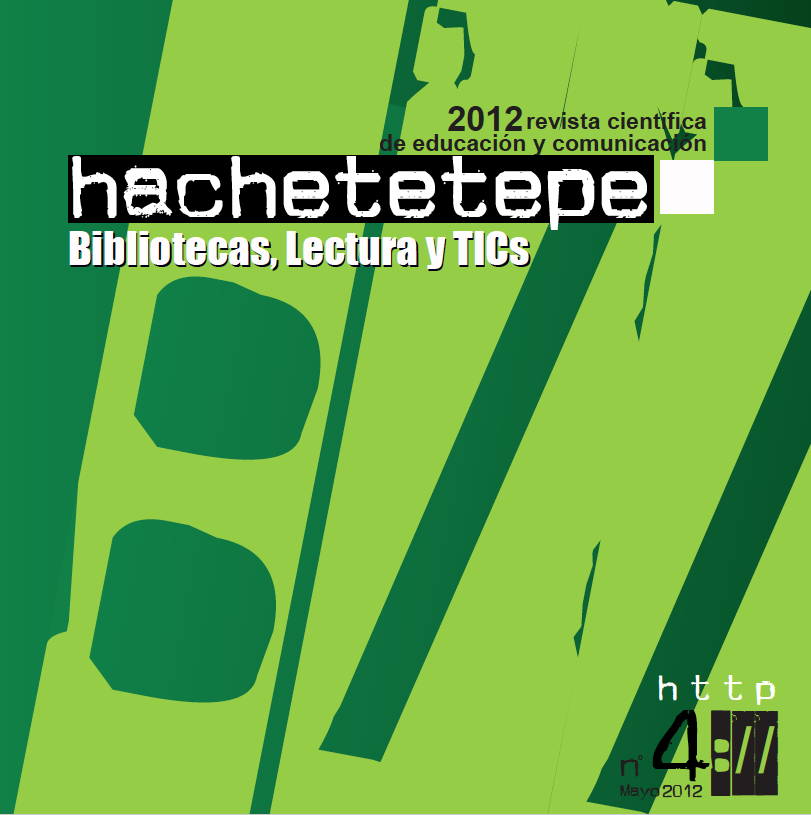Bibliotecas y tecnologías sociales

Información
Resumen
Las bibliotecas se han adaptado a lo largo de su historia a las innovaciones tecnológicas de cada momento, para mejorar el servicio que prestan a sus usuarios, de la misma forma que ahora se han adaptado a los imperativos de la web social o web 2.0, incorporando y adecuando a sus objetivos, las tecnologías y aplicaciones sociales. Tras la Web social, hace su aparición la Web semántica y con ella nuevas tecnologías y aplicaciones que las bibliotecas deben incorporar. En este artículo se plantean las bases tecnológicas y conceptuales de la web social y se describen las aplicaciones y la forma en la que los bibliotecarios las han incorporado a sus productos y servicios, en una continua adaptación a los medios y expectativas de sus comunidades, pero atentos a las nuevas tecnologías emergentes que están apareciendo en el horizonte y pueden mejorar el servicio que prestan.
Palabras clave
Descargas
Cómo citar
Licencia

Esta obra está bajo una licencia internacional Creative Commons Atribución-NoComercial-SinDerivadas 4.0.
Aquellos autores/as que tengan publicaciones con esta revista, aceptan los términos siguientes:
- Conservarán sus derechos de autor y garantizarán a la revista el derecho de primera publicación de su obra, el cual estará simultáneamente sujeto a la Licencia de reconocimiento de Creative Commons. Se pueden copiar, usar, difundir, transmitir y exponer públicamente, siempre que se cite la autoría, la url, y la revista, y no se usen para fines comerciales. No se permite hacer obras derivadas.
- Podrán adoptar otros acuerdos de licencia no exclusiva de distribución de la versión de la obra publicada (p. ej.: depositarla en un archivo telemático institucional o publicarla en un volumen monográfico) siempre que se indique la publicación inicial en esta revista.
- Difundir su obra a través de Internet (p. ej.: en archivos telemáticos institucionales o en su página web) una vez que el manuscrito sea aceptado, lo cual puede producir intercambios interesantes y aumentar las citas de la obra publicada. (Véase El efecto del acceso abierto)
Hachetetepé. Revista científica de educación y comunicación no cobra honorarios ni por la presentación de manuscritos ni por la publicación de sus artículos.
Citas
Actas del V Congreso Nacional de Bibliotecas Públicas: 3-5 de noviembre de 2010. Gijón, Ministerio de Educación, Cultura y Deporte.
(http://www.mcu.es/bibliotecas/MC/2010/CongresoBP/Programa.html) (Consultada el 28 de febrero de 2012).
Arroyo-Vázquez, N. (2011). La biblioteca desde una aplicación móvil. Anuario ThinkEPI, 5. (http://www.thinkepi.net/la-biblioteca-desde-una-aplicacion-movil) (Consultada el 28 de febrero de 2012).
Arroyo-Vázquez, N. (2012). Foursquare: tu biblioteca en el momento y en el lugar adecuados. Anuario ThinkEPI, 6. (http://www.thinkepi.net/foursquare-tu-biblioteca-en-el-momento-y-en-el-lugar-adecuados) Consultada el 28 de febrero de 2012).
Breeding, M. (2012). Tendencias actuales y futuras en Tecnologías de la información para unidades de información. El Profesional de la Información, 21; 1; 9-15.
(http://www.elprofesionaldelainformacion.com/breeding-espanol.pdf) (28-02-12).
Casey, M. E.; Savastinuk, L. C. (2006). Library 2.0, en Library Journal, 131; 14; 40-42.
Chua, A. Y. K.; Goh, D. H. (2010). A study of Web 2.0 applications in library websites, en Library & Information Science Research, 32; 3, 203-211
Codina, L; Marcos, M-C.; Pedraza, R. (2009). Web Semántica y Sistemas de Información Documental. Gijón: Trea
Freire, J. (2011). ¿Qué es la tecnología social?. Nómada, blog de Juan Freire (http://nomada.blogs.com/jfreire/2011/08/qu-es-la-tecnologa-social.html) (Consultada el 28 de febrero de 2012).
Gómez Pereda, N.; Merlo Vega, J. A. (2010). Experiencias bibliotecarias con las tecnologías sociales. Educación y Biblioteca, 177, mayo-junio. (http://www.baratz.es/portals/0/noticias/Dossier Educaci%C3%B3n y Biblioteca.pdf ) (Consultada el 28 de febrero de 2012).
González Fernández-Villavicencio, N.; Moscoso Castillo, M. (2007). Tecnologías para la biblioteca 2.0. VII Workshops REBIUN. (http://www.slideshare.net/nievesglez/tecnologias-para-la-biblioteca-20) (Consultada el 28 de febrero de 2012).
González Fernández-Villavicencio, N. (2009). Bibliotecas y marketing en red. BiD: textos universitaris de biblioteconomia i documentació, 23. (http://www.ub.edu/bid/23/gonzalez2.htm) (Consultada el 28 de febrero de 2012).
González Fernández-Villavicencio, N. (2011). OPAC móvil, MOPAC para los amigos. Bibliotecarios 2.0. (http://www.nievesglez.com/2011/05/opac-movil-mopac-para-los-amigos.html) (Consultada el 28 de febrero de 2012).
Kaplan Andreas M.; Haenlein M. (2010). Users of the world, unite! The challenges and opportunities of social media, en Business Horizons, 53; 1; 59-68.
Merlo Vega, J. A. (2008). Las diez claves de la Web social. Anuario ThinkEPI, 2. (http://www.thinkepi.net/las-diez-claves-de-la-web-social) (Consultada el 28 de febrero de 2012).
REBIUN (2011). Ciencia 2.0, Aplicación de la Web social a la investigación. Edición revisada y actualizada. (http://eprints.rclis.org/bitstream/10760/3867/1/Ciencia20_rebiun.pdf) (Consultada el 28 de febrero de 2012).
Reig, D. (2011). Historia, interactividad, flexibilidad, personalización, inteligencia, cinco claves para una conversación actual en la Web. El Caparazón. (http://www.dreig.eu/caparazon/2011/02/08/historia-interactividad-flexibilidad-personalizacion-inteligencia-cinco-claves-para-una-conversacion-actual-en-la-web/)
(Consultada el 28 de febrero de 2012).
Vállez, M.; Marcos, M. C. (2009). Las bibliotecas en un entorno Web 2.0. Hipertext.net. 7. (http://www.upf.edu/hipertextnet/numero-7/bibliotecas-2.0.html) (Consultada el 28 de febrero de 2012).

